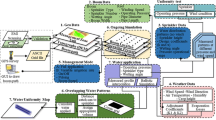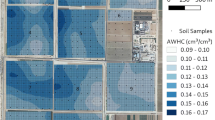Abstract
Standard evaluation procedures, based on field measurements and statistical, hydraulic models, have been developed for assessing irrigation systems performance. However, given the diverse nature of the irrigation methods, it is not possible to use a unique evaluation procedure. Ideally, variables would be measured at every point throughout the field under study, but that is clearly impractical. Instead, measurements are taken of selected samples, or irrigation models are used to predict field-wide distributions of the variables. In this paper, irrigation models for trickle, sprinkler and furrow irrigation are used to assess how well the irrigation performance indicators generated by standard procedures match those generated by whole-field simulations. Six performance indicators were used: distribution uniformity, uniformity coefficient of Christiansen, application efficiency, deep percolation ratio, tail water ratio and requirement efficiency. The analysis was applied to systems typical of cotton crops in Southern Spain. The results show that the procedure used to determine performance indicators in trickle irrigation provides good estimates of the whole field performance. The procedure used in sprinkler irrigation is also acceptable, but yields variable results. Finally, the standard procedure used for furrow irrigation produces biased, highly variable results and overestimates distribution uniformity.







Similar content being viewed by others
References
Anyoji H, Wu IP (1994) Normal distribution water application for drip irrigation schedules. Trans ASAE 37:159–164
Burt CM, Clemmens AJ, Strelkoff TS, Solomon KH, Bliesner RD, Hardy LA, Howell TA, Eisenhauer DE (1997) Irrigation performance measures: efficiency and uniformity. J Irrig Drain Eng 123:423–442
Christiansen JE (1942) Irrigation by sprinkling. Univ Calif Berkeley Agric Exp Sta Bull 670
Clemmens AJ (1981) Evaluation of infiltration measurements for border irrigation. Agric Water Manage 3:251–267
Clemmens AJ, Solomon KH (1997) Estimation of global irrigation distribution uniformity. J Irrig Drain Div Eng 123:454–461
Cogels OG (1983) An irrigation system uniformity function relating the effective uniformity of water application to the scale of influence of the plant root zones. Irrig Sci 4:289–299
Cunge JA, Holly FM, Verwey A (1980) Practical aspects of computational river hydraulics. Pitman Publishing, London, p 420
Fukui Y, Nakanishi K, Okamura S (1980) Computer evaluation of sprinkler irrigation uniformity. Irrig Sci 2:23–32
Hanson B, Bowers W, Davidoff B, Kasapligil D, Carvajal A, Bendixen W (1995) Field performance of microirrigation systems. Microirrigation for a changing world: conserving resources/preserving the environment. In: Proceedings of the 5th international microirrigation congress, FL, USA
Hart WE (1972) Subsurface distribution of nonuniformly applied surface waters. Trans ASAE 15:656–661, 666
Keller J, Bliesner RD (1990) Sprinkler and trickle irrigation. Chapman & Hall, New York NY, p 652
Mateos L (1998) Assessing whole-field uniformity of stationary sprinkler irrigation systems. Irrig Sci 18:73–81
Mateos L, Mantovani EC, Villalobos FJ (1997) Cotton response to non-uniformity of conventional sprinkler irrigation. Irrig Sci 17:47–52
Merriam JL, Keller J (1978) Farm irrigation system evaluation: a guide for management, 3rd edn. Utah State University, Logan, p 285
Oyonarte NA, Mateos L (2002) Accounting for soil variability in the evaluation of furrow irrigation. Trans ASAE 45:85–94
Oyonarte NA, Mateos L, Palomo MJ (2002) Infiltration variability in furrow irrigation. J Irrig Drain Eng 128:26–33
Seginer I (1979) Irrigation uniformity related to horizontal extent of root zone: a computation study. Irrig Sci 1:89–96
Solomon KH (1985) Global uniformity of trickle irrigation systems. Trans ASAE 28:1151–1158
Tarjuelo JM, Valiente M, Lozoya J (1992) Working conditions of sprinkler to optimize application of water. J Irrig Drain Eng 118:895–913
Walker WR, Skogerboe GV (1987) Surface irrigation. Theory and practice. Prentice-Hall, Englewood Cliffs, p 386
Watters GZ, Keller J (1978) Trickle irrigation tubing hydraulics. ASAE technical paper no 78-2015
Wilcox JC, Swailes GE (1947) Uniformity of water distribution by some undertree orchard sprinklers. Sci Agric 127:565–583
Wu IP (1988) Linearized water application function for drip irrigation schedules. Trans ASAE 31:1743–1749
Zerihum D, Sanchez CA, Farrell-Poe KL (2001) Analysis and design of furrow irrigation systems. J Irrig Drain Eng 127:161–169
Author information
Authors and Affiliations
Corresponding author
Additional information
Communicated by S. Ortega-Farias
Rights and permissions
About this article
Cite this article
Mateos, L. A simulation study of comparison of the evaluation procedures for three irrigation methods. Irrig Sci 25, 75–83 (2006). https://doi.org/10.1007/s00271-006-0036-x
Received:
Accepted:
Published:
Issue Date:
DOI: https://doi.org/10.1007/s00271-006-0036-x




